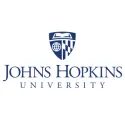
“What are we aiming at?”
That’s the question our first president, Daniel Coit Gilman, asked at his inauguration in 1876. What is this place all about, exactly? His answer:
“The encouragement of research . . . and the advancement of individual scholars, who by their excellence will advance the sciences they pursue, and the society where they dwell.”
Gilman believed that teaching and research go hand in hand—that success in one depends on success in the other—and that a modern university must do both well. He also believed that sharing our knowledge and discoveries would help make the world a better place.
Visit The Johns Hopkins University website.